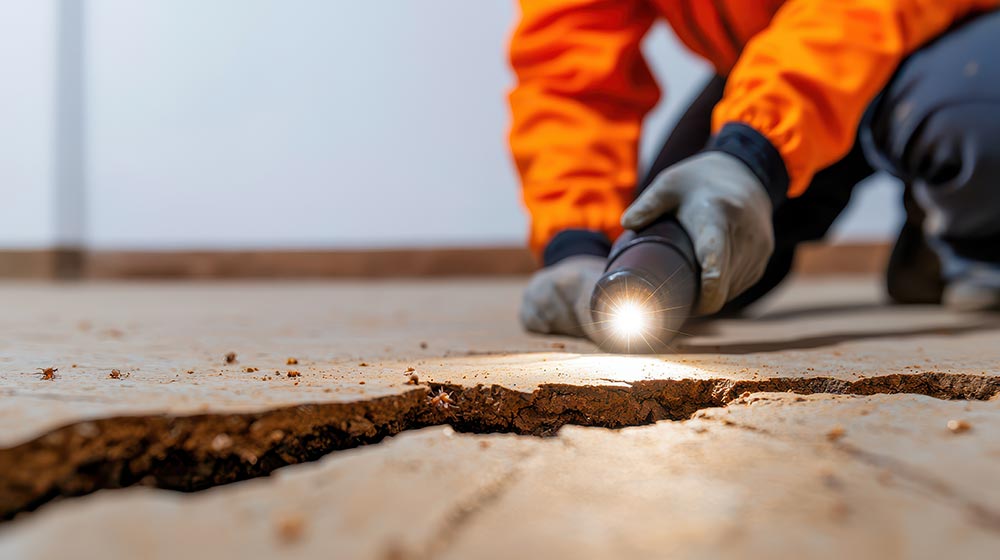The foundation can provide a strong and stable base. It makes sure the building it supports stays level and safe to use. It can also keep moisture and shifting soil from damaging or weakening the structure. Minor settling is something you can expect foundations to experience over time, but there are some situations where a homeowner should be concerned about a settling foundation. Cracks in interior walls, noticeable floor sloping, or doors and windows that no longer open or close can be signs of a more serious problem.

Why Does a House Settle?
When you walk on the beach, the sand compacts and shifts under your weight. The soil under your home is doing the same thing, and it started when it was first built. Before the foundation was poured, the builder dug down to undisturbed soil at the construction site. If it’s done well, the “settling” that happens will cause minor and gradual adjustments over a long period of time.
After the home has been built, a number of factors can affect the settling process. Some of them include the following:
- Temperature fluctuations.
- Changes in humidity and moisture levels.
- The type of concrete being used.
- The local water table.
All of these things will have some impact. But in most cases, the initial settling of a home happens in the first three years. Any settling that happens after those three years will be minimal and in small increments.
What is the Difference Between Foundation Settling and a More Serious Issue?
It can be hard to tell the difference between normal foundation settling and more serious foundation problems, but here are some things to consider as you look at your specific situation:
- Crack patterns and sizes — The type, size, and pattern of cracks can give you valuable information about the nature of a foundation issue. Vertical cracks are usually not as concerning, because they may be the result of normal settling. But if you see any horizontal or diagonal cracks (especially if they’re wider than 1/8 of an inch), it may indicate a more serious problem. The presence of multiple cracks or ones that form a pattern (such as stair-step cracks in brick walls) can also indicate a more serious foundation issue.
- The age of your home — Newer homes that are less than ten years old may experience more settling, because the structure is still adjusting to the surrounding soil. But if an older home suddenly develops this kind of problem, its foundation may be experiencing soil or drainage issues.
If you’re in doubt about any of this, be sure to speak with a professional for more information.
How Do You Know if You Have a Foundation Problem?
If you have already found some signs of trouble, here are some things that you should watch out for:
- Are the cracks larger than hairline or in many different places?
- Are the cracks both inside and outside your home?
- Are there cracks around your doors and windows?
- Do your doors and windows open and close smoothly?
You should also check to see if any water is seeping through your foundation or crawlspace, because it creates hydrostatic pressure when water accumulates around the foundation. Any amount of water intrusion is a sign that your foundation is under stress. It can also stimulate mold growth, which is a health risk for both you and your family. Horizontal cracks, stair-step cracks, or bowing in the walls are also signs that hydrostatic pressure is weakening your foundation.
What are Some of the Red Flags That Require Immediate Attention?
Here are some of the warning signs that can indicate a serious foundation problem:
- Sudden or large cracks that appear in walls or floors.
- Doors and windows that suddenly become hard to open or close.
- Visible gaps between walls, ceilings, or floors.
- Water is coming in from under your floor.
If you notice any of these signs, you should contact a professional to get it taken care of as soon as possible.
How Can You Prevent Foundation Problems?
If you want to maintain the structural integrity of your home’s foundation, you need to manage the water flow effectively. This will include the following:
- Making sure gutters and downspouts can direct water away from the foundation.
- Maintaining proper grading around the house by making sure it slopes away from the foundation.
You should think about installing a French drain system if you’re experiencing more persistent drainage issues. If you’re looking for one of the best places for foundation repair in Corpus Christi, be sure to reach out to Streem Foundation Repair.
